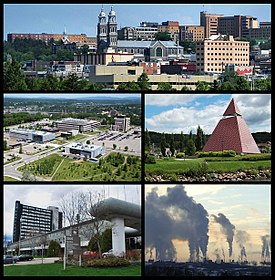
Back Saguenay Afrikaans ساغينيه Arabic Saguenay ATJ Сагнэ BE-X-OLD Saguenay Catalan Saguenay (lungsod) CEB Saguenay Czech Saguenay (Stadt) German Saguenay, Quebec DIQ Σαγκναί Greek
Saguenay | |
|---|---|
| Ville de Saguenay | |
 From top, left to right: Downtown Chicoutimi borough, the UQAC, the Ha! Ha! Pyramid, the Cégep de Jonquière, and Rio Tinto's aluminium smelters in Arvida | |
| Coordinates: 48°25′N 71°04′W / 48.417°N 71.067°W[1] | |
| Country | Canada |
| Province | Quebec |
| Region | Saguenay–Lac-Saint-Jean |
| RCM | None |
| Settled | 1840s |
| Constituted | February 18, 2002 |
| Boroughs | |
| Government | |
| • Type | Saguenay City Council |
| • Mayor | Julie Dufour |
| • Federal riding | Chicoutimi—Le Fjord and Jonquière |
| • Prov. riding | Chicoutimi, Dubuc and Jonquière |
| Area | |
| • City | 1,279.70 km2 (494.09 sq mi) |
| • Land | 1,124.63 km2 (434.22 sq mi) |
| • Urban | 94.56 km2 (36.51 sq mi) |
| • Metro | 3,133.53 km2 (1,209.86 sq mi) |
| Elevation | 166 m (545 ft) |
| Population (2021)[3] | |
| • City | 144,723 |
| • Density | 128.7/km2 (333/sq mi) |
| • Urban | 103,934 |
| • Urban density | 1,099.1/km2 (2,847/sq mi) |
| • Metro | 161,567 |
| • Metro density | 51.6/km2 (134/sq mi) |
| • Pop (2016–21) | |
| • Dwellings | 71,017 |
| Time zone | UTC−5 (EST) |
| • Summer (DST) | UTC−4 (EDT) |
| Postal code(s) | |
| Area code(s) | 418 and 581 |
| GDP (Saguenay CMA) | CA$6.7 billion (2016)[6] |
| GDP per capita (Saguenay CMA) | CA$41,639 (2016) |
| Website | ville |
Saguenay (/ˈsæɡəneɪ, ˌsæɡəˈneɪ/ SAG-ə-nay, -NAY, French: [saɡnɛ], locally [-ne]) is a city in the Saguenay–Lac-Saint-Jean region of Quebec, Canada, on the Saguenay River, about 200 kilometres (120 mi) north of Quebec City by overland route. It is about 126 kilometres (78 mi) upriver and northwest of Tadoussac, located at the confluence with the St. Lawrence River. It was formed in 2002 by merging the cities of Chicoutimi and Jonquière and the town of La Baie. Chicoutimi was founded by French colonists in 1676. As of July 2021, the city had a population of 145,000 and the metropolitan area had a population of 165,000.[7]
The city of Saguenay constitutes a territory equivalent to a regional county municipality (TE); its geographical code is 941. Together with the regional county municipality of Le Fjord-du-Saguenay, it forms the census division (CD) of Le Saguenay-et-son-Fjord (94). The mayor of Saguenay since 2021 is Julie Dufour. Prior to its use as the name of the city, the term "the Saguenay" or (less commonly) "Saguenay Valley" had already been used for the whole Saguenay River region (see Saguenay–Lac-Saint-Jean).[8] Saguenay is the seat of the judicial district of Chicoutimi.[9]
The city is divided into three boroughs: Chicoutimi (which includes the former city of Chicoutimi, as well as Laterrière and Tremblay township), Jonquière (which includes the former city of Jonquière, Lac-Kénogami, and Shipshaw) and La Baie (which corresponds to the former city of La Baie).
The name Saguenay is possibly derived from the Innu word "Saki-nip", which means "where water flows out".[10][11]
- ^ "Banque de noms de lieux du Québec: Reference number 371249". toponymie.gouv.qc.ca (in French). Commission de toponymie du Québec.
- ^ a b Ministère des Affaires municipales, des Régions et de l'Occupation du territoire — Répertoire des municipalités: Saguenay Archived March 15, 2012, at the Wayback Machine
- ^ a b "Census Profile — Saguenay, Ville". Canada 2021 Census. Statistics Canada. March 29, 2023. Retrieved July 27, 2023.
- ^ a b "Census Profile — Chicoutimi-Jonquière (Population Centre)". Canada 2021 Census. Statistics Canada. March 29, 2023. Retrieved July 27, 2023.
- ^ a b "Census Profile — Saguenay (Census Metropolitan Area)". Canada 2021 Census. Statistics Canada. March 29, 2023. Retrieved July 26, 2023.. The census metropolitan area consists of Saguenay, Bégin, Ferland-et-Boilleau, Larouche, Saint-Charles-de-Bourget, Saint-David-de-Falardeau, Saint-Fulgence, Saint-Félix-d'Otis, Saint-Honoré, Sainte-Rose-du-Nord.
- ^ "Table 36-10-0468-01 Gross domestic product (GDP) at basic prices, by census metropolitan area (CMA) (x 1,000,000)". Statistics Canada. January 27, 2017. Archived from the original on January 22, 2021. Retrieved April 27, 2021.
- ^ "Estimation de la population des régions métropolitaines de recensement (RMR), Québec, 1ᵉʳ juillet 2001 à 2022" (in French). Institut de la statistique du Québec. Retrieved January 5, 2024.
- ^ Allen, H. D. (May 1968). "Le Saguenay: Region in Transition". The Teachers' Magazine. XLVIII (242). Montreal: Provincial Association of Protestant Teachers of Quebec: 10.
- ^ Territorial Division Act. Revised Statutes of Quebec D-11.
- ^ "La rivière et chemin du Royaume et terre du Saguenay". histoirequebec.qc.ca (in French). Archived from the original on October 25, 2007.
- ^ "Histoire du Saguenay depuis les origines jusqu'à 1870". Our Roots / Nos Racines (in French). University of Calgary, Université Laval. Archived from the original on June 15, 2011.
© MMXXIII Rich X Search. We shall prevail. All rights reserved. Rich X Search

